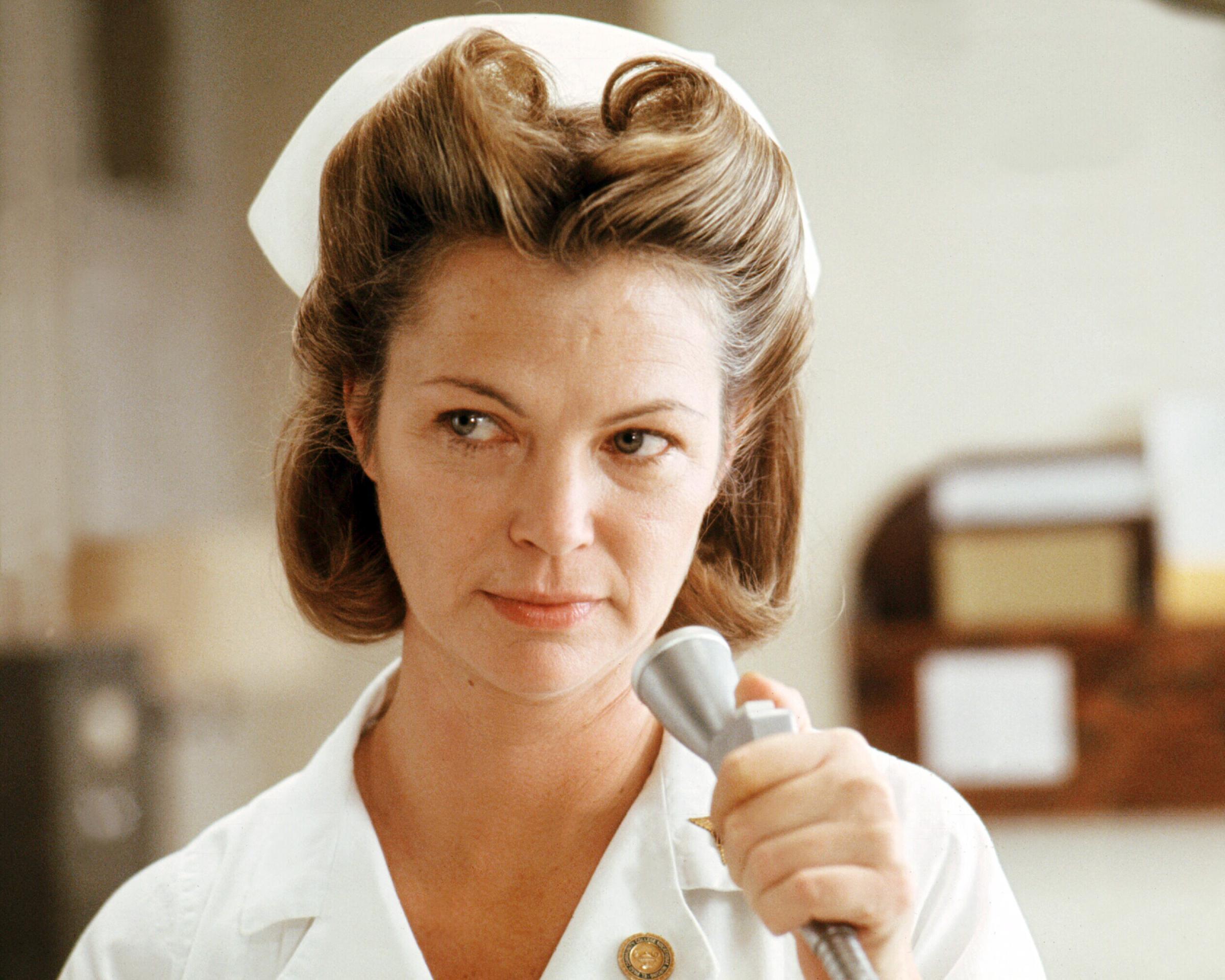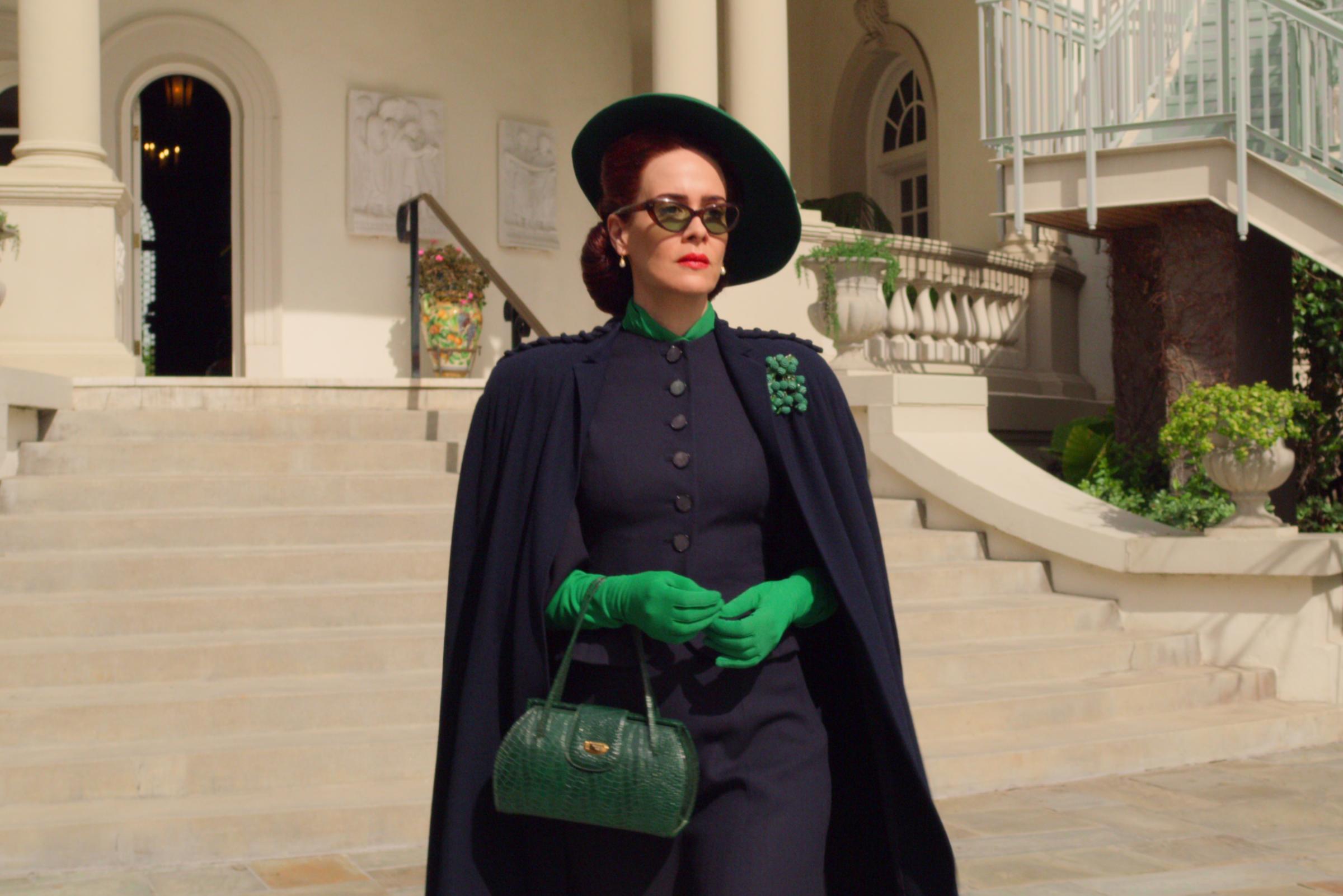When the world first meets Nurse Ratched, the cruel asylum nurse in Ken Kesey’s 1962 novel One Flew Over the Cuckoo’s Nest, she’s characterized in terrifying terms. She’s too comfortable unlocking doors, her movements sudden and unsettling. Cold air seems to follow her, and even the color of her fingernails sparks fear. “Funny orange,” the novel’s narrator remarks. “Like the tip of a soldering iron. Color so hot or so cold if she touches you with it you can’t tell which.”
Big Nurse, as she’s called in the book, holds a lobotomy-loving reign over a fictional Oregon psychiatric hospital, where she meets her match in a disruptive new patient, Randle Patrick McMurphy. He wants to see the end of her control, leading the two to engage in an infamous power struggle that results in Ratched’s place as one of literature’s most loathsome antiheroes. In 1975, Miloš Forman’s movie adaptation introduced Ratched’s brutal tendencies and inhumane behavior to an even bigger audience. The American Film Institute ranks the character, played by Louise Fletcher in an Academy-Award winning performance, as the fifth greatest movie villain of all time.
But how, exactly, did Nurse Ratched become so evil? The new Netflix series Ratched, starring Sarah Paulson as the titular nurse, aims to answer that question. The series, which Paulson also executive-produced alongside frequent collaborator Ryan Murphy, imagines a complex backstory for a character long understood only in the context of Cuckoo’s Nest. Ratched also gives the nurse a first name: Mildred. (Jack Nicholson calls her “Mildred” in one scene in the 1975 film adaptation, based on a side conversation in which Fletcher told him she’d made up the name for the character, but that name never appeared in Ken Kesey’s novel).
Read More: How Ryan Murphy Became King of the Streaming Boom
“I feel like Nurse Ratched is sort of a shorthand for barbarism. She became almost like a catchphrase for any sort of institutional abuse of power,” Murphy told Vanity Fair in July. “What was interesting was trying to create an emotional character from a reputation that’s very cold.” Here’s what to know about that reputation and its roots, from the way in which Kesey depicted Ratched in his writing to the evolving reception of her character over the years and her legacy as an iconic villain.
The original Big Nurse
In Kesey’s novel, we see the rise and fall of Nurse Ratched through the narration of Chief Bromden, a patient who has been at the hospital for several years. His descriptions of Ratched often center on her physical traits—the size of her breasts, the twists of her smile—in his ongoing observations of the escalating tensions between her and McMurphy. What ensues is a revolution, led by McMurphy, to take down Nurse Ratched and correct the supposed power imbalance of the hospital.
Kesey drew inspiration for the novel from his work in two part-time jobs, one as a paid subject in a U.S. Army research project on the effect of mind-altering drugs and the other as an orderly working the night shift in a psychiatric ward. His experiences helped shape the characters in Cuckoo’s Nest—and one specific nurse from the ward was the inspiration behind Nurse Ratched. Not long before his death in 2001, the author told the New York Times that he ran into the real woman a few years prior to the interview. “She was much smaller than I remembered, and a whole lot more human,” he said.

Cuckoo’s Nest offers few clues into Ratched’s life before she appeared at the hospital. The patients speculate as to how she became so mean, but never land on any real answers. There’s a mystery that surrounds Ratched’s past, though it is revealed that she trained as an Army Nurse. Louise Fletcher was celebrated for portraying Nurse Ratched in a more well-rounded light in the 1975 film adaptation. Fletcher told Vanity Fair in 2018 that she filled in her character’s history, just for herself, sharing that she believed Nurse Ratched was a 40-year-old virgin who was “very turned on” by McMurphy. In his review of the movie for the Hollywood Reporter, Arthur Knight wrote at the time of its release that “Fletcher gives a human dimension to this inhuman creature that makes the characterization frighteningly real and true.”
The character’s reception
Academics have long examined the role women play in the novel and what Nurse Ratched represents. In a 1975 paper published by the Johns Hopkins University Press, scholar Elizabeth McMahan acknowledged the novel’s teachability, but urged instructors to discuss the sexism in the text. “The Big Nurse happens also to be the Big Victim when viewed with an awareness of the social and economic exploitation of women,” McMahan wrote.
Kesey’s focus on Nurse Ratched’s size and physical traits also garnered criticism. “Big Nurse’s size is but one of the many ways in which she embodies American machismo’s worst nightmare—a powerful woman who is unattracted to them,” wrote Philip Darbyshire in a 1994 feminist critique of the character. McMurphy, who had been arrested for statutory rape before arriving at the hospital, has been described as “a Jesus figure” in the novel, according to Darbyshire. “Such hero figures require a symbiotic relationship with a villain,” he wrote.
In tracing Nurse Ratched’s arc as a character who initially refuses to be sexually available to the male patients, Darbyshire outlined how the novel’s ending celebrates sexual violence when she’s physically attacked by McMurphy. In that scene, her uniform is torn off and her breasts are exposed. It is then, Darbyshire argued, that “Nurse Ratched is at last revealed as the sexual being that the men always ‘knew’ that she would be.”
But is there value, at least from a feminist perspective, in the fact that, for the majority of the novel, Nurse Ratched has authority over all the men? Scholar Patricia Reis argued that there is in a 1987 paper published by Indiana University Press. She explained that the asylum is a matriarchy with Big Nurse acting as “the attendant mother goddess” in a stunning reversal of the usual patriarchal structure of psychiatric facilities. As she wrote, “In a bizarre (but not uncommon) and highly effective reversal, Kesey has taken all of the aspects of a totalitarian system, its controlling, brutalizing, dehumanization (defeminization), and projected these onto matriarchy, and the devouring mother.”
Kesey was, naturally, aware of the response to the character. He told the Times in 2001 “that whole thing reached its peak about 15 years ago.” He did not go on to specifically address whether he thought the criticisms of Nurse Ratched were valid. (As he wrote in a 1964 letter to the New York Times, “The answering of one’s critics has always struck me as doing about as much good as fighting crabgrass with manure”).
The female villain origin story

Despite the debate over the misogynistic characterization of Nurse Ratched in the novel, she is still regarded as an iconic villain in pop culture. She’s so disliked that Louise Fletcher remembers viewing a screening of the movie in Chicago for the first time and watching the audience actively root against the character. Fletcher described to Vanity Fair that she saw audience members shout “Kill her!” during the scene in which McMurphy strangles Nurse Ratched.
The desire to give malicious female characters like Nurse Ratched origin stories is not new. The trend has often reflected a desire for feminist reappraisals of characters not previously viewed within the full context of a sexist society—whether stemming from their creators’ genuine curiosity or movie studios smelling opportunity. In the realm of literature, Jean Rhys imagined the backstory for the mad wife from Jane Eyre in her 1966 novel Wide Sargasso Sea. Gregory Maguire explored the life of the Wicked Witch of the West before the events of The Wizard of Oz in his 1995 novel Wicked: The Life and Times of the Wicked Witch of the West, which served as the basis for the hit musical. In her 2018 novel Circe, Madeline Miller painted the sorceress from Homer’s Odyssey in a new light.
In recent years, many of these stories have centered on characters from fairy tales and comic books. In 2004, Halle Berry starred in the much maligned Catwoman. The 2014 film Maleficent and its 2019 sequel tell the backstory of Disney’s iconic evil fairy from Sleeping Beauty, and Emma Stone will star as a punk-rock Cruella de Vil, the scary dog-snatcher from 101 Dalmations, in Disney’s upcoming live-action prequel Cruella. While Harley Quinn got her backstory in the pages of comic books in the 1990s, her character further pervaded the cultural consciousness in the 2016 film Suicide Squad, after which Margot Robbie produced and starred in this year’s spin-off Birds of Prey. Meanwhile on the small screen, the Hulu horror anthology Castle Rock took a stab at a younger version of Misery’s Annie Wilkes, who ranks not far below Ratched on AFI’s list of villains.
Uncovering these characters’ journeys allows readers and audiences to see them in a new light—whether that means empathizing with the human behind the terrible actions, or merely better understanding their motivations. In an interview with Parade, Paulson shared that the new Netflix series would be an opportunity for viewers to understand how Mildred Ratched became who she is in the film that most people know her from. “You get to see Mildred’s loneliness, her rage,” she says. “She doesn’t have to keep everything under the surface the way Louise Fletcher’s nurse did.”
Correction, Sept. 30
The original version of this story misstated the title of Jean Rhys’ novel. It is Wide Sargasso Sea, not Wild Sargasso Sea.
More Must-Reads from TIME
- Why Trump’s Message Worked on Latino Men
- What Trump’s Win Could Mean for Housing
- The 100 Must-Read Books of 2024
- Sleep Doctors Share the 1 Tip That’s Changed Their Lives
- Column: Let’s Bring Back Romance
- What It’s Like to Have Long COVID As a Kid
- FX’s Say Nothing Is the Must-Watch Political Thriller of 2024
- Merle Bombardieri Is Helping People Make the Baby Decision
Write to Annabel Gutterman at annabel.gutterman@time.com